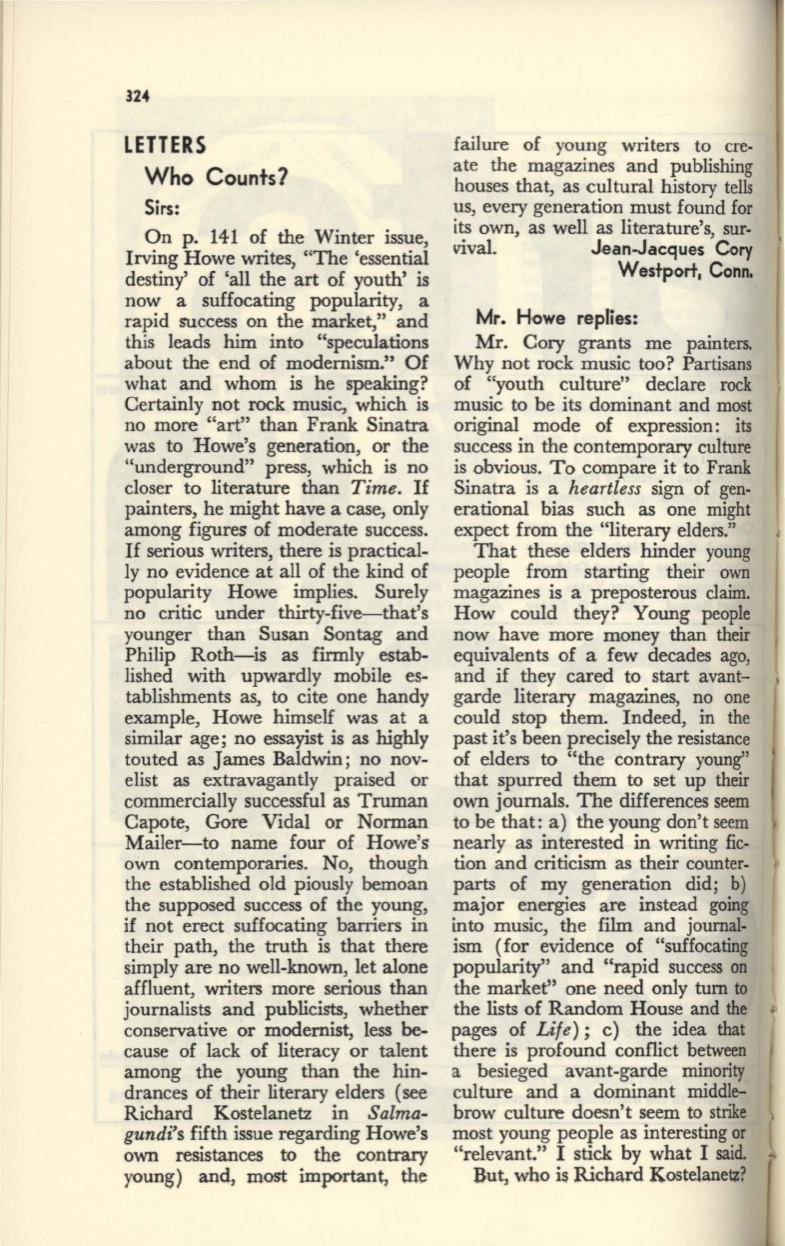
324
LETTERS
Who Counts?
Sirs:
'On p. 141 of the Winter issue,
Irving Howe writes, "The 'essential
destiny' of 'all the art of youth' is
now a suffocating popularity, a
rapid success on the market," and
this leads him into "speculations
about the end of modernism." Of
what and whom is he speaking?
Certainly not rock music, which is
no more "art" than Frank Sinatra
was to Howe's generation, or the
"underground" press, which is no
closer to literature than
Time.
If
painters, he might have a case, only
among figures of moderate success.
If
serious writers, there is practical–
ly no evidence at all of the kind of
popularity Howe implies. Surely
no critic under thirty-five-that's
younger than Susan Sontag and
Philip Roth-is as firmly estab–
lished with upwardly mobile es–
tablishments as, to cite one handy
example, Howe himself was at a
similar age; no essayist is as highly
touted as James Baldwin; no nov–
elist as extravagantly praised or
commercially successful as Truman
Capote, Gore Vidal or Norman
Mailer-to name four of Howe's
own contemporaries. No, though
the established old piously bemoan
the supposed success of the young,
if not erect suffocating barriers in
their path, the truth is that there
simply are no well-known, let alone
affluent, writers more serious than
journalists and publicists, whether
conservative or modernist, less be–
cause of lack of literacy or talent
among the young than the hin–
drances of their literary elders (see
Richard Kostelanetz in
Salma–
gundi's
fifth issue regarding Howe's
own resistances to the contrary
young) and, most importantl the
failure of young writers to cre–
ate the magazines and publishing
houses that, as cultural history tells
us, every generation must found for
its own, as well as literature's, sur–
vival.
Jean-Jacques
Cory
Westport, Conn.
Mr. Howe replies:
Mr. Cory grants me painters.
Why not rock music too? Partisans
of "youth culture" declare rock
music to be its dominant and most
original mode of expression: its
success in the contemporary culture
is obvious. To compare it to Frank
Sinatra is a
heartless
sign of gen–
erational bias such as one might
expect from the "literary elders."
That these elders hinder young
people from starting their own
magazines is a preposterous claim.
How could they? Young people
now have more money than their
equivalents of a few decades ago,
and if they cared to start avant–
garde literary magazines, no one
could stop them. Indeed, in the
past it's been precisely the resistance
of elders to "the contrary young"
that spurred them to set up their
own journals. The differences seem
to be that: a) the young don't seem
nearly as interested in writing fic–
tion and criticism as their counter–
parts of my generation did; b)
major energies are instead going
into music, the film and journal–
ism (for evidence of "suffocating
popularity" and "rapid success on
the market" one need only turn
to
the lists of Random House and the
pages of
Life);
c) the idea
that
there is profound conflict between
a besieged avant-garde minority
culture and a dominant middle–
brow culture doesn't seem to strike
most young people as interesting or
"relevant." I stick by what I
said.
But, who is Richard Kostelanetz?


